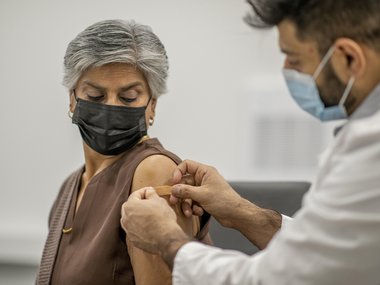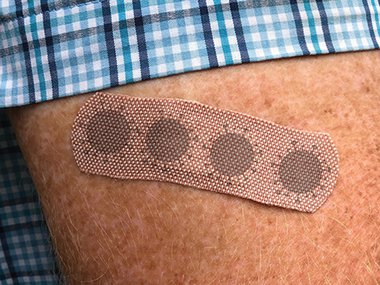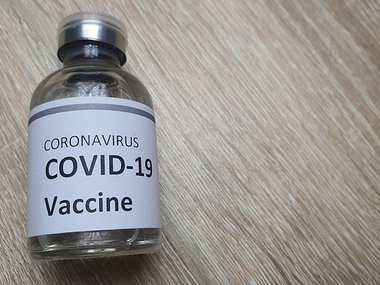Smallpox: The Scientific History from Variolation to Vaccination
What does smallpox have to do with our first president? Quite a lot, actually! As the commander in chief of the Continental Army, George Washington oversaw the first large-scale public vaccination program in American history during the Revolutionary War. To really tell that story, though, let's set the scene. Since smallpox has been effectively eradicated for decades, we'll go over its long history.
Smallpox is caused by a species of virus called Variola. It is highly transmissible between humans, and was at one time one of the most feared diseases in world. Evidence suggests humans may have suffered from smallpox since 10,000 BCE. Ancient Egyptian mummies show scarring that strongly resembles smallpox.
Recent research shows victims of smallpox would experience fevers, prostration and vomiting as well as the telltale fluid-filled lesions that erupted all over the body and even in the mouth. At the very least, victims would be left with disfiguring scars, but blindness was not uncommon. One severe variant was hemorrhagic smallpox, which did not cause the usual eruptions on the skin, but did cause massive internal bleeding. Most fearsome of all, smallpox often killed up to 30 percent of its sufferers, and infant death rates could possibly exceed 80 percent. In 18th century Europe it may have killed as many as 400,000 people per year. The one bright spot is that once a person survived smallpox they were immune for life.
Washington knew firsthand how dangerous smallpox could be. He and his brother Lawrence caught it as young men. Lawrence did not survive. In 1766 while he was commanding colonial troops under the British during the French and Indian War, Washington saw the campaign to take Quebec fail because many American soldiers were ravaged with smallpox. In 1775, a serious outbreak of smallpox spread across the colonies. As commanding general of the poorly-trained and equipped Continental Army, Washington was at a serious disadvantage against the professional soldiers of the British Army already, but he had an additional problem: many, if not most, of his soldiers had never had smallpox, while most of the European soldiers were immune. It is even a possibility that the British attempted to infect the American camps by sending infected civilians into them.

Photo: Illustration of Doctor Edward Jenner giving the world's first vaccine from 1894, Getty Images
Several times during campaigns, smallpox outbreaks in the American camps left many soldiers unfit for duty, and Washington was forced to quarantine newly arrived recruits away from the rest of his army until he was sure they were free from the disease. Many other potential recruits did not join the army at all, for fear of catching the disease in a crowded camp. All of this made Washington’s already difficult manpower situation even worse, but there was a solution: it was difficult and dangerous, but it had the potential to solve Washington’s smallpox problem.
Inoculation against smallpox may have been happening in China as early as the 10th century, and was widely practiced there by the 16th century. Eventually European physicians learned of it and began practicing it, also. The process involved taking a sample from the lesions on an infected person and placing it under the skin of someone who had never been infected using a needle, a process called “variolation.” The inoculated person would typically develop a mild case of smallpox and recover, although between 2 and 3 percent would die from the disease. It was also possible that other blood-borne diseases such as tuberculosis could be passed on to the patient. People who had undergone variolation were also contagious and had to be isolated for weeks until the smallpox had passed. It was a controversial procedure that many refused to undergo, and physicians who practiced it often suffered severe local opposition. As outbreaks in the army continued to worsen, by 1777 Washington felt as though he had little choice but to inoculate his men. Smallpox was a greater threat to his army than the British!
Although he knew it would mean making large portions of his army unfit for duty for weeks at a time, Washington moved his inoculation plan forward with the strictest possible secrecy and careful precautions against breaking quarantine. The British would surely have taken advantage of the situation if they found out.
At Fairfax, Dumfries, Alexandria, Valley Forge and other sites, the inoculation proceeded during the winter of 1777-1778 with great success. But while Washington’s army was now safe, many other people were not. Slaves and native peoples had long been particularly vulnerable to smallpox. As the virus moved across the continent with English, American, Portuguese and Spanish traders both before and after the 1775 outbreak, it left entire Native Americans civilizations nearly wiped out. Exposure to smallpox from the Spanish invasion was a major contributing factor to the fall of the Aztec Empire in the 16th century. In 1779, an outbreak in Mexico City infected over 44,000 people, killing around 18,000. While the outbreak of 1775 was largely over by 1782 according to written accounts, smallpox would continue to ravage Native American populations for an unknown period of time.
After the success of his inoculation program, Washington still had many problems to overcome for the remainder of the war, but it was the British Army that suffered ongoing problems with disease. Malaria was once endemic to many areas of the United States, including Virginia, and European soldiers had never been exposed to the strains of malaria that were carried by American mosquitoes. European troops infected by the bites of malarial mosquitoes could suffer severe illness and even death. Washington’s soldiers on the other hand had been exposed to the local malaria and were much less affected by it. At Yorktown in 1781 many of Cornwallis’s soldiers were too ill with malaria and other diseases to fight, contributing to the British surrender.
Smallpox was eventually defeated as better alternatives to variolation were developed. In 1796 English physician Edward Jenner experimented with inoculating patients using matter from cowpox lesions, a disease caused by another Variola virus, and similar to smallpox but much less contagious and dangerous to humans. He found that patients inoculated in this way did not contract smallpox when exposed to it. Though rural English physicians had long known of the association between cowpox and smallpox, and Jenner was not the first to experiment with it, his efforts at promotion greatly expanded its mainstream use. As a result of his work smallpox mortality began to decline, and vaccination completely replaced variolation by 1840. In the 1967 the World Health Organization established a program to eradicate the disease entirely, a goal achieved so completely that by 1980 they could recommend that all countries cease vaccination. This dreaded disease which killed untold millions and plagued George Washington’s army now exists only in laboratories.
Here's a look at a recent Lunch Break Science in which Dr. Terry Jones of the Institute of Virology at Charité Universitätsmedizin in Berlin and the Department of Zoology at Cambridge talked about how smallpox has affected humans throughout history.
For further reading on the American smallpox epidemic, check out Pox Americana: The Great Smallpox Epidemic of 1775-1782 by Dr. Elizabeth A. Fenn, Professor of History at the University of Colorado.
The Museum is hard at work helping you to discover your world despite dramatically reduced financial resources. If you'd like to help us continue this work, click here to learn how.


